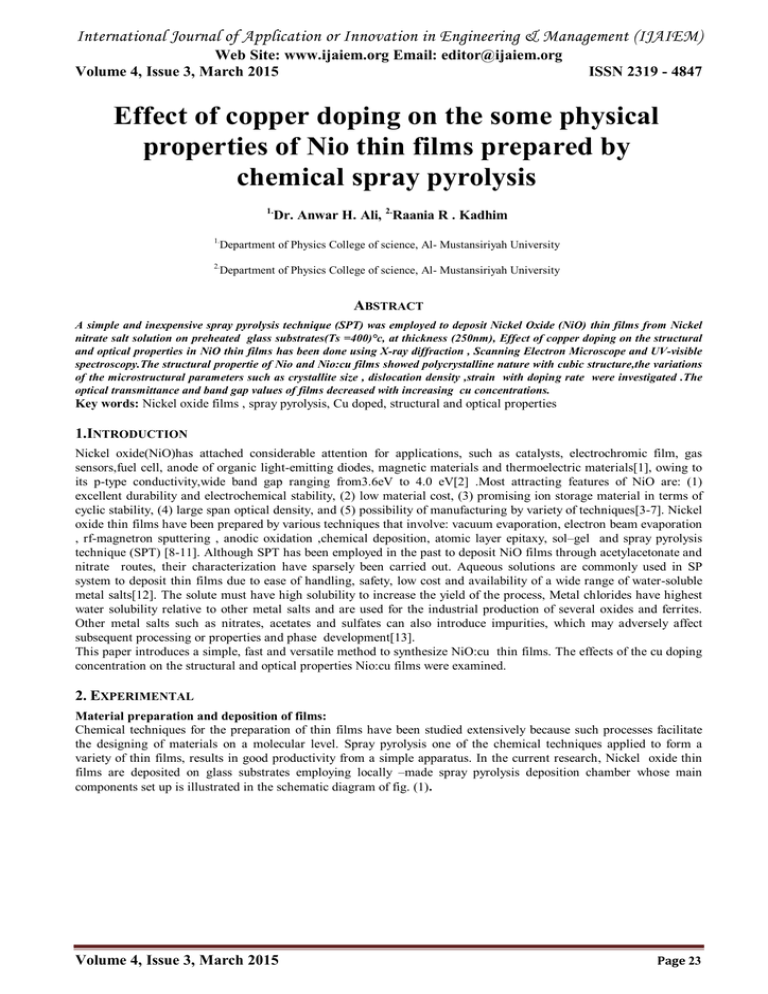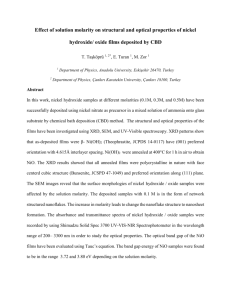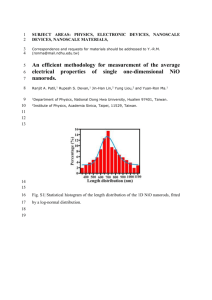Effect of copper doping on the some physical chemical spray pyrolysis
advertisement

International Journal of Application or Innovation in Engineering & Management (IJAIEM) Web Site: www.ijaiem.org Email: editor@ijaiem.org Volume 4, Issue 3, March 2015 ISSN 2319 - 4847 Effect of copper doping on the some physical properties of Nio thin films prepared by chemical spray pyrolysis 1. Dr. Anwar H. Ali, 2.Raania R . Kadhim 1. Department of Physics College of science, Al- Mustansiriyah University 2. Department of Physics College of science, Al- Mustansiriyah University ABSTRACT A simple and inexpensive spray pyrolysis technique (SPT) was employed to deposit Nickel Oxide (NiO) thin films from Nickel nitrate salt solution on preheated glass substrates(Ts =400)°c, at thickness (250nm), Effect of copper doping on the structural and optical properties in NiO thin films has been done using X-ray diffraction , Scanning Electron Microscope and UV-visible spectroscopy.The structural propertie of Nio and Nio:cu films showed polycrystalline nature with cubic structure,the variations of the microstructural parameters such as crystallite size , dislocation density ,strain with doping rate were investigated .The optical transmittance and band gap values of films decreased with increasing cu concentrations. Key words: Nickel oxide films , spray pyrolysis, Cu doped, structural and optical properties 1.INTRODUCTION Nickel oxide(NiO)has attached considerable attention for applications, such as catalysts, electrochromic film, gas sensors,fuel cell, anode of organic light-emitting diodes, magnetic materials and thermoelectric materials[1], owing to its p-type conductivity,wide band gap ranging from3.6eV to 4.0 eV[2] .Most attracting features of NiO are: (1) excellent durability and electrochemical stability, (2) low material cost, (3) promising ion storage material in terms of cyclic stability, (4) large span optical density, and (5) possibility of manufacturing by variety of techniques[3-7]. Nickel oxide thin films have been prepared by various techniques that involve: vacuum evaporation, electron beam evaporation , rf-magnetron sputtering , anodic oxidation ,chemical deposition, atomic layer epitaxy, sol–gel and spray pyrolysis technique (SPT) [8-11]. Although SPT has been employed in the past to deposit NiO films through acetylacetonate and nitrate routes, their characterization have sparsely been carried out. Aqueous solutions are commonly used in SP system to deposit thin films due to ease of handling, safety, low cost and availability of a wide range of water-soluble metal salts[12]. The solute must have high solubility to increase the yield of the process, Metal chlorides have highest water solubility relative to other metal salts and are used for the industrial production of several oxides and ferrites. Other metal salts such as nitrates, acetates and sulfates can also introduce impurities, which may adversely affect subsequent processing or properties and phase development[13]. This paper introduces a simple, fast and versatile method to synthesize NiO:cu thin films. The effects of the cu doping concentration on the structural and optical properties Nio:cu films were examined. 2. EXPERIMENTAL Material preparation and deposition of films: Chemical techniques for the preparation of thin films have been studied extensively because such processes facilitate the designing of materials on a molecular level. Spray pyrolysis one of the chemical techniques applied to form a variety of thin films, results in good productivity from a simple apparatus. In the current research, Nickel oxide thin films are deposited on glass substrates employing locally –made spray pyrolysis deposition chamber whose main components set up is illustrated in the schematic diagram of fig. (1). Volume 4, Issue 3, March 2015 Page 23 International Journal of Application or Innovation in Engineering & Management (IJAIEM) Web Site: www.ijaiem.org Email: editor@ijaiem.org Volume 4, Issue 3, March 2015 ISSN 2319 - 4847 Nickel oxide thin films have been deposited from 0.04 M aqueous solution of solute quantity of Ni(No3)2 in distilled water (the solvent).A magnetic stirrer is incorporated for this purpose for about (10–15) minutes to facilitate the complete dissolution of the solute in the solvent. A microscopic glass substrates were chemically and ultrasonically cleaned are employing , during the film deposition the substrate temperature was kept constant at 400 °C. This temperature was found to be optimum to obtain good adherent NiO films. The spray rate was maintained at2.3 ml/min due to the (N2) pressure of gas. and distance between top of nozzle and the substrate was kept 30 cm. The overall reaction process can be expressed as heat decomposition of Nickel nitrate to clusters of Nickel oxide in the presence of water and air. The following chemical reaction took place on heated substrates[14]. Table (1): Optimum thermal spray pyrolysis deposition conditions for the preparation of NiO thin films. For copper doping(Cu(NO3)2 ) was dissolved in precursor solution of Ni(No3)2 with different weight percentage and sprayed onto preheated glass substrate. The Cu doped films were prepared for 1%, 3%, 5%,and7% of copper concentrations with the same deposition temperature and spray rate. 3. RESULTS AND DISCUSSION 3.1 Structural Properties The crystalline structure of the thin films, obtained at different doping concentrations were examined by Philips instrument system at room temperature, X-ray diffractometer using CuKα radiation with wavelength, λ=1•54056Ao.The crystalline size of Nickel oxide thin film samples were calculated by using Scherrer's equation [15], and there values are listed in table(2). Volume 4, Issue 3, March 2015 Page 24 International Journal of Application or Innovation in Engineering & Management (IJAIEM) Web Site: www.ijaiem.org Email: editor@ijaiem.org Volume 4, Issue 3, March 2015 ISSN 2319 - 4847 (Scherrer's equation) where D is the crystalline size β: the peak FWHM. θ: the diffraction peak position, it means Bragg`s angle XRD pattern of NiO thin film prepared by spray pyrolysis technique at substrate temperature of (400oC) have been shown in Figure (2 (a) ).The presence of diffraction peaks indicates that the Nio film is polycrystalline with a cubic type crystal structure as compared with standard (ASTM) NiO card . Generally the peaks of the Nio and NiO:Cu thin films were observed at diffraction angles in the range at (37°and 43°),the results show amajor diffraction peak along (111)plane at 2Ɵ=37.3°for pure Nio and different copper concentrations.besides this other low intensity peak was observed along (200)plane. No diffraction peak related to other secondary phases was observed ,the crystalline size shows a variation in different copper doping as listed in table (2). Fig.(2): X-ray diffraction patterns of (a) NiO (b) Nio:cu1% (c)Nio:cu3% (d)Nio:cu 5% (f)Nio:cu 7% Table (2): Structural properties of pure Nio and Nio:cu at different concentration 3.2 Optical properties The transmittance of Nio and doped NiO films, deposited on glass substrates, prepared at various doping rates are presented in Fig. (3) of pure NiO and film show a transmittance (< 60%). The transmittance of pure Nio was nearly 60% and it decreased to be 40% at Nio:cu 1% is added.By futher increasing Cu contents to 3%,5%, and 7% the transmittances of Nio films are decreased to 38%,37%,28% recpactibly . this results may be ascribed to the light being scattered by large amounts of grain boundaries as well as The Cu clusters also reflecting the incident light ,therefore the transmittance of Nio:Cu films decreases with the increase in Cu content. The optical band gap (Eg) of the thin films could be obtained as shown in Fig.(4) by plotting (αhν)2 vs hν curve (α) is the absorption coefficient and hν the photon energy and extrapolating the straight-line portion of this plot to the energy axis.The absorption coefficient (α) has been calculated using the following eqution for directly allowed transition for simple parabolic scheme as a function of incident photon energy. Volume 4, Issue 3, March 2015 Page 25 International Journal of Application or Innovation in Engineering & Management (IJAIEM) Web Site: www.ijaiem.org Email: editor@ijaiem.org Volume 4, Issue 3, March 2015 ISSN 2319 - 4847 Lambert’s formula (Mishra et al. 2009) [16] where, t is a thickness of the film (250nm), T is a transmittance of the film. The optical band gap of NiO: cu films gradually decreases from 3.9 ev to 2.8 eV with increasing Cu concentration as illustrated in Fig.(4) . This shift is due to the increase in carrier concentration which results in filling prevents the transition of the photo generate carriers into the filled levels according to quantum rules and hence leads so far transition with larger photo energy. Fig.(5) show the change of the absorption coefficient of undoped and doped films as a function of incident photon energy, It is observed that the absorption coefficient (α) increases gradually with the incident photon energy, and that value is greater than 179350.4 (cm-1) for Nio:cu 7% , which indicates the strong possibility of direct electronic transitions, we can see the absorption coefficient (α) increase with increasing the copper concentration this mean decreasing in energy gap , this result is attributed to form levels nearby conductive band. Fig.(3): Transmittance spectra of pure NiO , Nio:cu 1%,Nio :cu 3%,Nio :cu 5% and Nio:cu 7% thin films. Fig. (4): Variation of ( h ) 2 vs. photon energy ( h ) for pure Nio, Nio:cu 1%,Nio :cu 3%, Nio:cu 7% thin films Nio :cu 5% and Fig (5): Absorption Coefficient versus photon energy of NiO and Nio:cu 1%, Nio :cu 3%,Nio :cu 5% and Nio:cu 7% thin films Volume 4, Issue 3, March 2015 Page 26 International Journal of Application or Innovation in Engineering & Management (IJAIEM) Web Site: www.ijaiem.org Email: editor@ijaiem.org Volume 4, Issue 3, March 2015 ISSN 2319 - 4847 2.3 Surface morphology Surface morphologies for pure NiO and all Nio:cu Thin films have been studied. Fig.(6) shows that the surface micrograph of NiO(pure) film have a homogenous surface which consists of a uniform distribution of structured grains with average grain size about ( 0.6808 Mm ). This structure repeats throughout the materials with closely packed to each other indicating good adhesiveness of film with the substrate. The image of Nio:cu 1% shows that the some particales were meet together to form a cluster, the surface was Less homogeneity and the effect of doping was clearly, with average grain size about ( 0.7234 Mm ).The SEM image of Nio :cu 3% is indicative of the formation of larger aggregation while the formation of relatively small grains is visible in SEM image corresponding to NiO:cu 1% thin films and the effect of doping was more clearly , the average grain size increase to (0.8255 Mm),it can be seen that the grain size of particales increase with decreasing Cu doping, this is attributed to the replacement of relatively smaller Ni⁺² ions by the relatively smaller Cu⁺²ions during the formation of the Nio:cu films. The image of Nio:cu 5% appears the shapes of aggregation of particales -like worms with average grain size about(0.7231 Mm) and homogenous surface.from the image of Nio:cu 7% It can be seen that the small grains made a smooth and best homogeneous thin films with uniform distribution and have a Spherical shap and the average grain size about( 0.4255 Mm),this result is in a good agreement with (XRD). Fig. (6) SEM micrographs Nio:Cu thin at different doping rates at two magnification. 4.CONCLUSION We have found that good adherent and smooth films of copper doped NiO having different percentage of copper concentration canbe obtained by using low cost spray pyrolysis technique. From the X-ray diffraction investigation, the crystalline structure of thin films was a polycrystalline with a cubic structure , the increasing of cu doping concentration increased the grain size, The SEM results reveal that the grain size increases with the increase in copper Volume 4, Issue 3, March 2015 Page 27 International Journal of Application or Innovation in Engineering & Management (IJAIEM) Web Site: www.ijaiem.org Email: editor@ijaiem.org Volume 4, Issue 3, March 2015 ISSN 2319 - 4847 concentration and then decreased and this affects the physical properties of the films The value of The transmittance and the optical energy gap (Eg)were found decrease with increase cu doping concentration. Value addition to this study is the observation of higher absorption in the visible region,thereby a tendency towards tunability for applications. REFERENCES [1] Wu SY, Ch WF, Fe YF. The electrochromic properties of nickel oxide by chemical deposition and oxidization. Mater Lett60:790–5 2006. [2] Bo JA,Ij,DM,IV PG,Er RW,Lee SH,etal.Polarized neutron diffractionstudiesofexchange-coupledFe3O4/NiO superlattices. [3] H.M. Al-doon, Phys. Stat. Solidi (a) (1988). [4] S. Ma, A. Akl, H. Kamal and K. Ab-Hady, Physica, (2002) 366–375. [5] LiuZG,ZuYG,FuYJ,ZhangYL,LiangHL.Growthoftheoxidizednickel nanoparticles onaDNAtemplateinaqueoussolution.MaterLett2008;62: 2315–2307. [6] Cast-HurtadoI,HerranJ,PerezN,OlaizolaSM,MandayoGG,CastanoE. Toxic gasesdetectionbyNiOsputteredthinfilms.SensLett2011;9:64–68. [7] DuY,WangWN,LiXW,ZhaoJ,MaJM,LiuYP,etal.PreparationofNiO nanoparticles inmicroemulsionanditsgassensingperformance.MaterLett 2012;68:168–170. [8] LiY,XieYS,GongJH,ChenYF,ZhangZT.PreparationofNi/YSZmaterialsfor SOFC anodesbybuffersolutionmethod.MaterSciEng,2001;86:119–122. [9] BorchersJA,IjiriY,LindDM,IvanovPG,ErwinRW,LeeSH,etal.Polarized neutron diffractionstudiesofexchangecoupledFe3O4/NiO superlattices. J ApplPhys1999;85:5883–5885. [10] HuY,Qian HS,MeiT,Guo J,WhiteT.Facile synthesis of magnetic metal(Mn, Co, Fe,and Ni)oxidenanosheets.MaterLett2010;64:1095–1098. [11] BijuV.Antiferromagneticresonanceinnanocrystallinenickeloxidestudied using fouriertransforminfraredspectroscopy.MaterLett2008;62:2904–2906. [12] Gandhi AC,Huang CY,Yang CC,ChanTS,ChengCL,MaYR,etal.Growth mechanism and magnonexcitation in NiO nanowalls.Nanoscale Res Lett 2011. [13] ShinW,MurayamaN.High performancep-type thermo electric oxide based on NiO.MaterLett2000;45:302–306. [14] Bogoroditsky N.P., V.V. Pasnkov & B.M. Tareev, ‘ Electrical Engineering Materials’, (1979 ). [15] B.D.Cullity, "Elements of X-ray diffraction",(USA: Addison-Wesley Publishing Co.) 1956. [16] Mishra RL, Mishra SK, Prakash SG Optical and gas sensing characteristics of tin oxide nano-crystalline thin film. J Ovonic Res(2009) 5(4):77–85. AUTHOR Raania R. kadhim Volume 4, Issue 3, March 2015 Page 28




